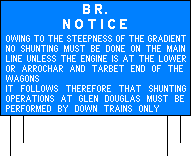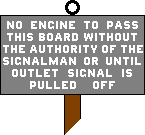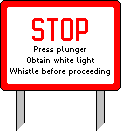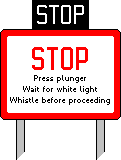|
|
|
A notice board conveys information or gives instructions in words, for miscellaneous purposes not catered for by any specific alternative sign.
The wording exhibited on a notice board can range from simple pieces of information [26.1] to instructions that are verging on verbose [26.2]. Some early notice boards were fitted with a white light for location purposes [26.3].
 |
 |
 |
|
[26.1] Notice Board.
Area: All Areas Usage: High Status: Current |
[26.2] Notice Board.
Area: All Areas Usage: High Status: Current |
[26.3] Notice Board with Location Light.
Area: All Areas Usage: High Status: Obsolescent |
|---|
A particular situation where a notice board would commonly be provided is where the method of working changes to or from a signalling system that requires the driver to obtain a staff or token as authority to occupy the section of line ahead [26.4 & 26.5]. These notice boards will frequently be found affixed to signal posts.
 |
 |
|
[26.4] Notice Board at start of Token Section.
Area: All Areas Usage: High Status: Current |
[26.5] Notice Board at end of Token Section (e.g. RETB).
Area: All Areas Usage: High Status: Current |
|---|
Similarly, notice boards will often be installed where 'yard working' is in force [26.6 & 26.7].
 |
 |
[26.6] Notice Board at start of Yard Working area.

Area: All Areas Usage: High Status: Current |
[26.7] Notice Board at end of Yard Working area.
Area: All Areas Usage: High Status: Current |
|---|
|
Notice boards are commonly provided in electrified areas to advise traincrews where a specific line or lines beyond is inaccessible to electric trains [26.8]. |
|
In contrast to the GWR's "stop" lamps, most notice boards bearing the word "stop" carry some additional instructions detailing the action to be taken by the traincrew before a movement is permitted to pass the board. Known as 'stop boards', they originally comprised a variety of different styles [26.10 - 26.12].
 |
 |
 |
|
[26.10] Stop Board.
Area: London Midland Region Usage: High Status: Obsolescent |
[26.11] Stop Board.
Area: Eastern Region Usage: High Status: Obsolescent |
[26.12] Stop Board.
Area: Southern Region Usage: High Status: Obsolescent |
|---|
From the late 1960s, increasing usage of stop boards on running lines (at level crossings, for example), where they have a status similar to that of a stop signal, required that they be given greater prominence. As well as being of a larger size and surrounded by a wide red border [26.13], some of the earliest examples were accompanied by an illuminated indicator showing the word "stop" [26.14].
 |
 |
|
[26.13] Stop Board.
Area: All Areas Usage: Medium Status: Historical |
[26.14] Stop Board with Illuminated "Stop" Indicator.
Area: All Areas Usage: Medium Status: Historical |
|---|
The standard stop board format later became an upright grey rectangular board on which the instruction to stop was emphasised by the word "stop" being superimposed in white on a large red disc [26.15]. The additional instructions were contained within a white rectangular area below the red disc. By 1972, that format had been superseded by a new style of stop board comprising a white board, divided into two parts by a black horizontal line. The upper part incorporates the red disc with the word "stop" underneath, whilst the lower part contains the additional instructions [26.16].
 |
 |
[26.15] Stop Board.

Area: All Areas Usage: High Status: Obsolescent |
[26.16] Stop Board.

Area: All Areas Usage: High Status: Current |
|---|
A driver issued with a 'long section' token on a line worked by the Radio Electronic Token Block (RETB) system is permitted to pass the stop board at the intermediate token exchange point without stopping or contacting the signalman. Since October 1987, the stop boards concerned have carried a supplementary sign with a yellow background [26.17]. The wording on the supplementary sign may be modified to include any additional instructions that may be relevant [26.18]. Upon the conversion of certain level crossings on the Cambrian Lines to Automatic Half Barrier (AHB) type in 1989/1990 for example, the supplementary signs (where provided) on the stop boards at the entrances to the sections concerned were altered to include additional instructions relating to those level crossings.
 |
 |
|
[26.17] Stop Board with Supplementary Sign.
Area: Various Usage: Medium Status: Current |
[26.18] Stop Board with Supplementary Sign giving additional instructions.
Area: Various Usage: Low Status: Current |
|---|
|
A stop board that carries no additional instructions below the word "stop" [26.19] cannot be passed under any circumstances, except where a movement authority is granted by other means, such as a 'proceed' aspect exhibited by an associated shunting signal (see Section 4). |
|
|
A notice board may need to show instructions that only apply to a specific class of train. In this case, the instructions may be surrounded by a blue border, with the relevant class of train stated at the top of the board [26.20]. |
|
At stations where the front of the train is required to stop beyond the end of the platform there is a risk that the driver, having lost sight of the platform, might release the doors on the wrong side of the train. In such cases a notice board [26.21 - 26.23] may be placed at the relevant stop marker (see Section 21) as a reminder, particularly where it is located on the opposite side of the track from the platform.
 |
 |
 |
|
[26.21] Door Release Reminder Sign.
Area: Southern Usage: Low Status: Current |
[26.22] Door Release Reminder Sign.
Area: Virgin Trains Usage: Low Status: Current |
[26.23] Door Release Reminder Sign.
Area: Various Usage: Low Status: Current |
|---|
|
In some instances, a notice board may be surmounted by a triangular board showing an exclamation mark [26.24] in the style of a signal reminder board (see [8.87]). |
|
|
In May 2019, the stop board on the Down direction approach to Shiplake level crossing on the Henley-on-Thames branch (Western Route) was replaced as part of a trial. The wording on the new stop board requires the driver to sound the horn only in case of emergency or if anyone is seen on or near the line. The instructions below the word "stop" are awkwardly split between the upper part of the board and the lower part, which has a yellow background [26.25]. |
|
|